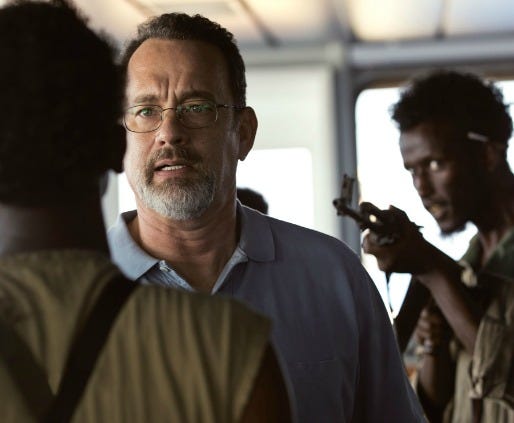Captain Phillips

“Captain Phillips” is, in some ways, two separate movies tied together by the same event: the first capture of an American ship by pirates since the 1800s. Both are equally effective at evoking a harrowing sense of tension even though we know the title character makes it out alive because the film is a chronicle of real events.
Based on a book co-written by the actual Captain Richard Phillips, the story starts out as the tale of a group of cargo-ship crewmen resisting armed intruders, a classic us-versus-them saga. The audience is encouraged to look upon the Somali pirates as bloodthirsty killers and thieves while the resolute captain (Tom Hanks) is the noble hero beset by them.
Then a curious thing happens, and the second half of the film shifts to the confines of a stuffy, tiny motorized lifeboat where the four pirates have escaped with Phillips as their abductee.
Screenwriter Billy Ray swings to an intimate character study, where we learn the Somalis are thinking, feeling individuals who capture ships not out of pure greed, but to appease the tyrannical warlord who rules them. They come from a society where men are valued by how much ransom money they bring in. Their desperation in many ways mirrors that of Phillips.
Director Paul Greengrass is a seasoned expert at portraying real, violent events with a clear eye and a steady hand (“United 93" and “Bloody Sunday”). By not over-dramatizing the proceedings and letting them play out with organic emotions, Greengrass manages to underline the humanity of the peril without becoming maudlin or manipulative.
And, of course, the movie is a showcase for yet another one of Hanks’ brilliant performances. He’s been so good for so long that we’ve come to expect nothing less than excellence out of his acting roles. In a perverse sort of homage, we tend to under-praise his efforts because of the high standard he has maintained for a quarter-century. I certainly hope the Academy Award voters this year do not do so.
I was pleased to find that Greengrass employed authentic African actors to play the Somalis rather than relying on performers from the U.S. or England or wherever. They all acquit themselves well, especially Barkhad Abdi as Muse, the scrappy, cagey pirate leader, and Faysal Ahmed as Najee, the excitable enforcer with whom Muse often butts heads.
Really, Phillips and Muse are the main characters of the piece, and Greengrass and Ray give us pivotal scenes of each man before, during and after their confrontation. We discover the two “captains” aren’t so very different than we’d imagined – including facing larger pressures from their superiors to carry out policies that won’t endear them to their underlings.
As Phillips himself puts it: “We’ve all got bosses.”
Things build to a fever pitch when a U.S. destroyer arrives on the scene, followed by a team of Navy sharpshooters. You may have already read the astounding account of how SEAL Team Six managed to put an end to the kidnapping, but seeing it rendered in sight and sound is a spellbinding experience.
The film’s version of events does omit some key facts, such as the fact the pirates’ comrades were trying to bring in other captured vessels carrying more than 50 hostages to act as human shields. It's a wise move from a storytelling standpoint, but it leaves the film open to charges of focusing on the plight of an American to the detriment of foreign-born victims.
The movie does not engage in so much equivocation as to make the Somali pirates seem blameless or the Americans unflawed. But in treating both the captors and captives as full-blooded human beings, “Captain Phillips” plumbs depths a lesser film would’ve skimmed over.
4.5 Yaps



